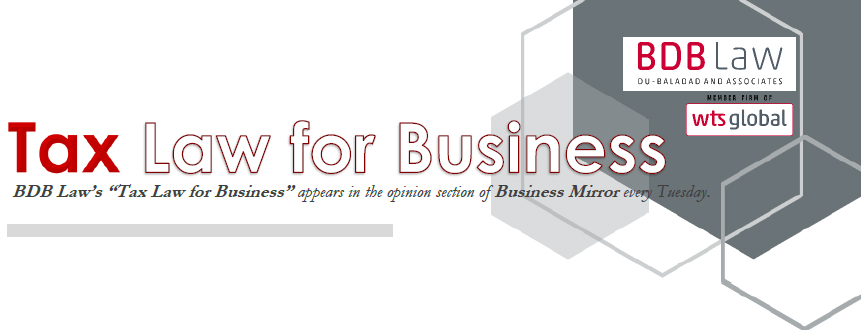
Best Evidence Obtainable in Assessment Cases
By Atty. Rodel C. Unciano
"While the law allows the Commissioner to assess based on “Best Evidence Obtainable” Rule, such power is not without limitation. If the assessment is barren of factual basis, arbitrary and illegal, such failure cannot serve as a basis for a finding that the taxpayer is liable for the amount of tax contained in the said assessment (GR No. L-13656). The presumption of correctness of an assessment, being a mere presumption, cannot be made to rest on another presumption (GR No. 136975)."
 Atty. Rodel C. Unciano +632 8403-2001 loc.380 |
Under existing rules, tax assessments are ordinarily based on the returns and documents submitted by the taxpayer during the examination. However, when a report required by law as basis of the assessment is not forthcoming within the time fixed by laws, or when there is reason to believe that the taxpayer’s reports are false, incomplete or erroneous, the Tax Code of 1997, as amended, authorizes the assessment of the correct amount of tax based on the “best evidence obtainable” rule.
 There is so far no definitive rule on what constitutes valid assessment based on the “best evidence obtainable” rule. Pursuant to Revenue Memorandum Circular (RMC) 23-00, an assessment based on best evidence obtainable is justified when the reports or records requested from the taxpayer are not forthcoming, such as when the records are lost or in case of refusal of the taxpayer to submit such records. Assessment based on best evidence obtainable is also justified in cases where the reports submitted are false, incomplete, or erroneous.
There is so far no definitive rule on what constitutes valid assessment based on the “best evidence obtainable” rule. Pursuant to Revenue Memorandum Circular (RMC) 23-00, an assessment based on best evidence obtainable is justified when the reports or records requested from the taxpayer are not forthcoming, such as when the records are lost or in case of refusal of the taxpayer to submit such records. Assessment based on best evidence obtainable is also justified in cases where the reports submitted are false, incomplete, or erroneous.
In a case, an assessment based on estimate was held to be valid in the absence of proof of any irregularities in the conduct of the examination. Even an assessment based on estimates is prima facie valid and lawful where it does not appear to have been arrived at arbitrarily or capriciously. The burden of proof is upon the complaining party to show clearly that the assessment is erroneous. Failure to present proof of error in the assessment will justify the assessment as valid.
The assessment based on “best evidence obtainable” rule was likewise held to be valid in case of non-presentation of taxpayer’s books of accounts. In this case, the taxpayer was found to have willfully and consistently neglected to file its corporate returns for four calendar years (GR No. L-11875). In another case, the Supreme Court likewise ruled that the assessment based on the “best evidence obtainable” applies when a tax report required by law for the purpose of assessment is not available or when the tax report is incomplete or fraudulent (GR No. 81446).
Also, in another case, the assessment of tax based on "Best Evidence Obtainable” rule was likewise held to be valid as there was showing that expenses have been incurred, but the exact amount thereof cannot be ascertained due to the taxpayer’s absence of documentary evidence. Here, the taxpayer was unable to present any accounting records or receipts to substantiate his expenses. Thus, the revenue officers were justified in making an assessment based on “Best Evidence Obtainable” rule where the disallowance of 50% of the claimed expenses was upheld (CTA Crim. Case Nos. O-287, O-288, O-289, O-290, and O-291, October 21, 2019).
However, while the law allows the Commissioner to assess based on “Best Evidence Obtainable” Rule, such power is not without limitation. If the assessment is barren of factual basis, arbitrary and illegal, such failure cannot serve as a basis for a finding that the taxpayer is liable for the amount of tax contained in the said assessment (GR No. L-13656). The presumption of correctness of an assessment, being a mere presumption, cannot be made to rest on another presumption (GR No. 136975).
In local taxation, the Presumptive Income Level of Assessment Approach (PILAA) may be used in computing the local business tax if the taxpayer is unable to provide proof of its gross sales or receipts. The PILAA may be used in estimating the gross sales or receipts provided that the PILAA is in the local tax ordinance and has undergone public hearings and publications. This is to ensure that the taxpayers are properly informed of the factors used in determining the presumptive income and for the taxpayers to agree such level of presumptive income applicable to their industry. Absent such ordinance authorizing the use of the PILAA embodying the presumptive income levels to be used by the Local Treasurer, the collection of additional local business taxes based on such PILAA is illegal.
In fine, taxpayers are reminded that assessments based on the “best evidence obtainable” rule and based on “presumptive income level of assessment approach” can stand the test of judicial scrutiny in the absence of proof of irregularity in the taxman’s examination and in the absence of justifiable grounds of failure to present pertinent documents for the taxman’s examination.
The author is a partner of Du-Baladad and Associates Law Offices (BDB Law), a member-firm of WTS Global.
The article is for general information only and is not intended, nor should be construed as a substitute for tax, legal or financial advice son any specific matter. Applicability of this article to any actual or particular tax or legal issue should be supported therefore by a professional study or advice. If you have any comments or questions concerning the article, you may e-mail the author at This email address is being protected from spambots. You need JavaScript enabled to view it. or call 8403-2001 local 140.




